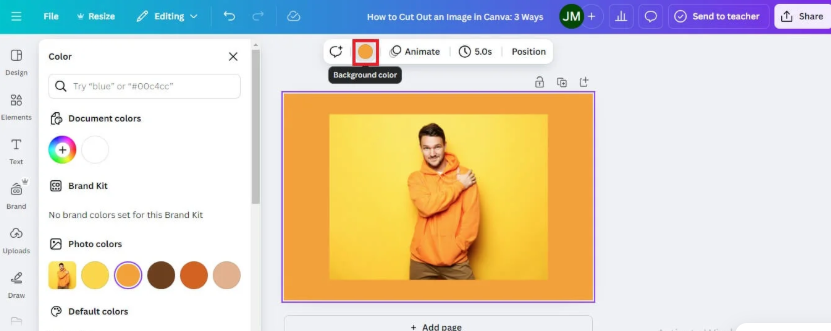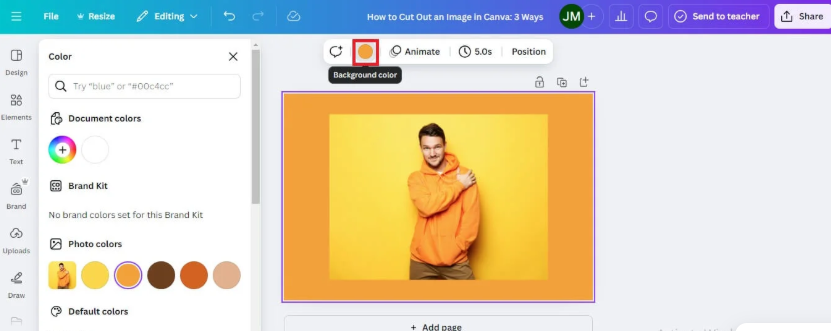Canva is one of the most popular graphic design tools used by professionals, marketers, and content creators worldwide. Whether you’re designing social media posts, presentations, or marketing materials, learning How to Fade an Image in Canva in 1 Minute can instantly elevate your design quality. The fade effect helps blend images seamlessly with backgrounds, create overlays for text, or achieve a minimalist aesthetic in your visuals.
In this guide, we’ll explainHow to Fade an Image in Canva in 1 Minute, including step-by-step instructions for both desktop and mobile users. We’ll also explore tips for adjusting transparency, How to Fade an Image in Canva in 1 Minute adding overlays, and using fade creatively for branding and content design.
Why Fading an Image in Canva Matters
Fading an image (or adjusting transparency) is a simple yet powerful design technique. It allows you to control how strongly an image appears on your canvas, letting you balance visual hierarchy and readability.
When you fade an image:
- Text becomes more readable: A slightly faded background image makes text stand out without distracting from the message.
- Designs look professional: Subtle fade effects give visuals a clean, balanced, and modern feel.
- Images blend seamlessly: You can mergeHow to Fade an Image in Canva in 1 Minute photos with colored backgrounds or gradients smoothly.
- Brand consistency improves: Transparency effects help unify visual How to Fade an Image in Canva in 1 Minute elements, making brand templates cohesive.
Understanding how to fade an image in Canva is therefore a must-have skill for both beginners and advanced designers.

Step-by-Step: How to Fade an Image in Canva (Desktop Version)
Follow these simple steps to fade or adjust the transparency of any image in Canva:
1. Open Your Design
Go to Canva and open your existing project or create a new design. How to Fade an Image in Canva in 1 Minute You can choose any template or set a custom dimension for your canvas.
2. Upload or Select an Image
If you’re using your own photo, click on “Uploads” → “Upload files” to add the image. Otherwise, browse Canva’s image library and select a photo that fits your design.
3. Add the Image to the Canvas
Click or drag the image onto your canvas. Adjust its position and size as needed.
4. Adjust Image Transparency

To fade the image in Canva, follow these quick steps:
- Select the image.
- Look for the Transparency icon (a small checkered square) on the top-right toolbar.
- Click the icon, then drag the How to Fade an Image in Canva in 1 Minute slider left to reduce opacity (lower numbers = more faded image).
You can experiment with values between 40–70% transparency for a soft and professional look.
5. Finalize and Save Your Design
Once you’re satisfied with the fade effect, download your design by How to Fade an Image in Canva in 1 Minute clicking “Share → Download”, and choose your preferred format (PNG, JPG, or PDF).
How to Fade an Image in Canva Mobile App
The process on Canva’s mobile app is slightly different but just as quick.
Step 1: Open Your Design on the Canva App
Launch the Canva app and open your desired project or create a new one.
Step 2: Insert or Upload an Image
Tap the “+” button, choose “Images”, and upload or select a photo from Canva’s library.
Step 3: Adjust the Image Transparency
- Tap the image to select it.
- At the bottom menu,How to Fade an Image in Canva in 1 Minute scroll sideways until you see “Transparency.”
- Use the slider to fade the image to your desired level.
Step 4: Save and Export
After adjusting the transparency, tap “Download” to save your design or share it directly to social media platforms.
That’s it — now you knowHow to Fade an Image in Canva in 1 Minute how to fade an image in Canva on both desktop and mobile in under one minute!
Creative Ways to Use the Fade Effect in Canva
The fade or transparency effect is more than just an editing tool — it’s a creative feature that enhances design storytelling. Here are some smart ways to use it:
1. Create Text Overlays
Fading the background image ensures that your How to Fade an Image in Canva in 1 Minuteheadline or call-to-action text remains legible. This is especially useful for social media banners, posters, and blog thumbnails.
2. Design Watermarks
Reduce opacity to around 10–20% to create a subtle watermark using your logo or brand icon. This keeps your design protected while maintaining visual appeal.
3. Build Layered Designs
Combine multiple images with varying opacityHow to Fade an Image in Canva in 1 Minute levels to create depth and texture. It’s a popular technique for professional web and presentation design.
4. Add Gradient Overlays
Apply a gradient element over your faded Combine multiple images with varying opacityHow to Fade an Image in Canva in 1 Minute levels to create depth and texture. It’s a popular technique for professional web and presentation design.
image to create cinematic or brand-colored effects. This technique works perfectly for hero banners and ad creatives.
5. Create Transparent Backgrounds for Collages
Use faded images to create visual balance when combining multiple pictures in collages or infographics.
Adjusting Transparency for Elements and Text
Fading in Canva isn’t limited to images. You can also Combine multiple images with varying opacityHow to Fade an Image in Canva in 1 Minute levels to create depth and texture. It’s a popular technique for professional web and presentation design.
adjust the transparency of text, shapes, stickers, or any graphic element to create consistent visuals.
To fade a text box:
- Select the text element.
- Click the Transparency icon.
- Move the slider left to reduce opacity.
This is particularly useful when you want to overlay text on an image while maintaining visual balance.
Using Fade with Canva Effects and Filters
In addition to the manual transparency slider, CanvaCombine multiple images with varying opacityHow to Fade an Image in Canva in 1 Minute levels to create depth and texture. It’s a popular technique for professional web and presentation design.
provides photo filters and effects that simulate fading through brightness and contrast adjustments.
To apply:
- Select your image.
- Click on “Edit photo.”
- Adjust Brightness, Contrast, and Blur to achieve a soft fade look.
For instance:
- Increasing brightness and reducing contrast can make an image appear more transparent.
- Adding a blur filter helps blend the background smoothly with other elements.
This method is ideal if you want a fade-like appearance without lowering transparency too much.
How to Fade the Background of an Image in Canva
If you want to fade only the background portion of an image (not the subject), use Canva’s Background Remover tool (available in Canva Pro):
- Select your image and click “Edit photo.”
- Choose “Background Remover.”
- Once the background is isolated, adjust the transparency of either the background or the main subject separately.
This technique helps create advanced visuals like portrait overlays or transparent mockups.
Troubleshooting: Why Can’t I Fade an Image in Canva?
If the transparency option isn’t showing, it may be due to one of these reasons:
- Incorrect selection: Ensure the image or element is actively selected before looking for the transparency slider.
- Using grouped elements: Ungroup multiple items first to adjust transparency individually.
- Free plan limitations: The fade feature is available for free users, but certain filters and effects require Canva Pro.
If issues persist, try refreshing your browser or updating the Canva app.
Canva Pro Tools That Enhance the Fade Effect
While the free version offers basic fading options, Canva Pro expands your design flexibility:
- Adjust background fade using layers
- Add transparency gradients
- Use blend modes (e.g., multiply, overlay)
- Combine transparent PNG exports for advanced editing
These tools allow greater precision when controlling visibility and lighting effects in designs.
Expert Tips for Perfect Fading in Canva
- Keep transparency consistent across elements to maintain balance.
- Use contrasting colors for text and faded images to ensure readability.
- For social media graphics, fade backgrounds to 50–70% opacity to enhance engagement.
- Avoid over-fading — too much transparency can make designs appear washed out.
- Combine fade with shadow and glow effects to add subtle depth.
Final Thoughts
Learning how to fade an image in Canva is one of the easiest yet most impactful design techniques you can master. In under a minute, you can transform your visuals into professional, clean, and attention-grabbing graphics.
Whether you’re creating YouTube thumbnails, presentations, or marketing ads, the fade tool helps achieve a balanced composition and enhances readability. Canva’s intuitive design platform makes it simple for anyone — from beginners to professionals — to apply transparency effects effectively.
By using the fade feature smartly, you can bring sophistication and visual harmony to every design you create.
https://hubdigitalcontent.com/tools/canva/how-to-fade-an-image-in-canva-in-1-min/

